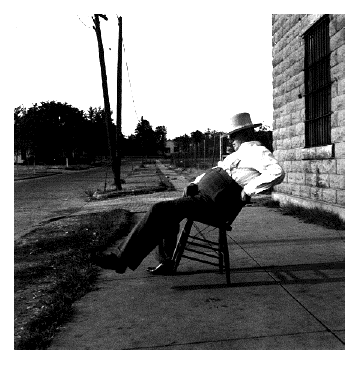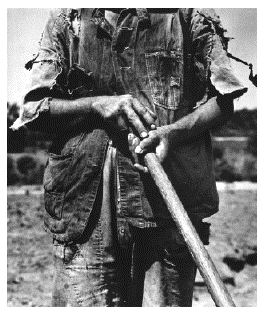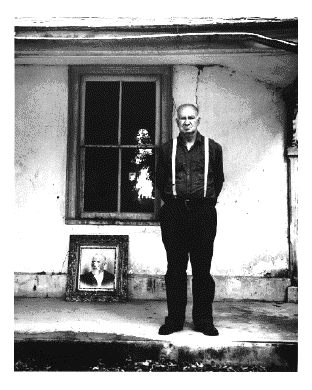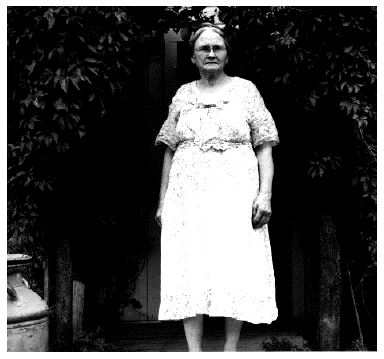Lange
Photographs of
A Lifetime
Edited by
Michael E. Hoffman
(Aperture)

They say that cameras do indeed take souls. That must be the secret: She knew she was in the soul-catch business, so she got good at it.
She was born in 1895 and got polio when she was seven which would cast her life so differently. In those days they put "cripples" in the back room, or out on the street to beg for money. She said, about the experience that left her with a life-long limp,
- It was perhaps the most important thing that happened to me. It formed me, guided, instructed me, helped me, and humiliated me. All those things at once. I've never gotten over it and am aware of the force and power of it.
 When she decided to become a photographer, she did it all. In those days, you didn't shoot some pictures and send them off to a "lab" to be processed. You chose the film, shot it with a camera you had probably modified in some way. You did the focus, the developing, the cropping. You made one of the thousand choices of light and contrast and size and cut --- all to create your vision, or what you thought was your vision.
When she decided to become a photographer, she did it all. In those days, you didn't shoot some pictures and send them off to a "lab" to be processed. You chose the film, shot it with a camera you had probably modified in some way. You did the focus, the developing, the cropping. You made one of the thousand choices of light and contrast and size and cut --- all to create your vision, or what you thought was your vision.
Exactly what was it, though, that turned her from a rich folks' portrait artist in San Francisco into one who would create some of the most haunting photographs of America of the depression, the American poor, Americans without home or hope? Maybe it was her pain from early on at seeing how the Indians of New Mexico were treated; maybe it was growing up poor and Jewish in a New Jersey ghetto; maybe it was being there when the migrant workers tried to come into California, and got pushed back. We were as scared of our poor back then as we are now, especially when they were on the move, going west, or coming over borders.
After she picked up the camera and said, "I'm going to be a photographer," her real chance came from chance. With the Depression Era Works Project Administration, the government simply gave artists a chance to practice their craft. Instead of requiring you to put together a mountainous grant request from the NEA, the feds went out and looked for people who were already doing it and said, "Here's some money. Go out and find some more people, just like yourself, who can help you with this project."
 In that way, they hired artists, painters, and sculptors. Even if you were some sort of an amateur, they'd probably take you on. If your work happened to be photography, you'd be hired on at the Farm Security Administration --- as Lange was --- to go out and just take pictures. Very easy, the simpler process of a simpler time. (It's different now: The people who get government money to do art projects don't have to know their craft; they have to know how to put together an application. You may not even know which end of the camera is the business end --- but if you prepare 200 or 300 pages of grant application with all the right words --- you get on the art dole.)
In that way, they hired artists, painters, and sculptors. Even if you were some sort of an amateur, they'd probably take you on. If your work happened to be photography, you'd be hired on at the Farm Security Administration --- as Lange was --- to go out and just take pictures. Very easy, the simpler process of a simpler time. (It's different now: The people who get government money to do art projects don't have to know their craft; they have to know how to put together an application. You may not even know which end of the camera is the business end --- but if you prepare 200 or 300 pages of grant application with all the right words --- you get on the art dole.)
Still, it wasn't all peaches and cream back then. There were complaints that the photographers were concentrating on the poor and the dispossessed. Senators from Mississippi and Oklahoma didn't like that. Reflected badly on their voters, their welfare projects. There were requests that FSA show "some successful farms and farmers." Pare Lorentz was to say,
- Lange, with her still pictures, and Steinbeck, with two novels, a play, and a motion picture, have done more for these tragic nomads than all the politicans in the country.
And Lange herself says, of her craft,
- You force yourself to watch and wait. You accept all the discomfort and the disharmony. Being out of your depth is a very uncomfortable thing ... You force yourself onto strange streets, among strangers. It may be very hot. It may be painfully cold. It may be sandy and windy and you say, "What am I doing here? What drives me to do this hard thing?"
 Aperture, with their usual art and grace and taste, give us here some 150 Lange photographs, including photos from her early days in San Francisco as well as a few from Egypt, India, and Ireland.
Aperture, with their usual art and grace and taste, give us here some 150 Lange photographs, including photos from her early days in San Francisco as well as a few from Egypt, India, and Ireland. The most famous are all here, including "Migrant Mother of Nipomo, California, 1936." Lange knew what she was doing. Even without cropping and cutting she knew she had found a face, the haunting face of an anguished mother, a face that would tell the story of an entire generation of the lost and the poor.
Photographs © 1978 City of Oakland,
The Dorothea Lange Collection,
Oakland Museum